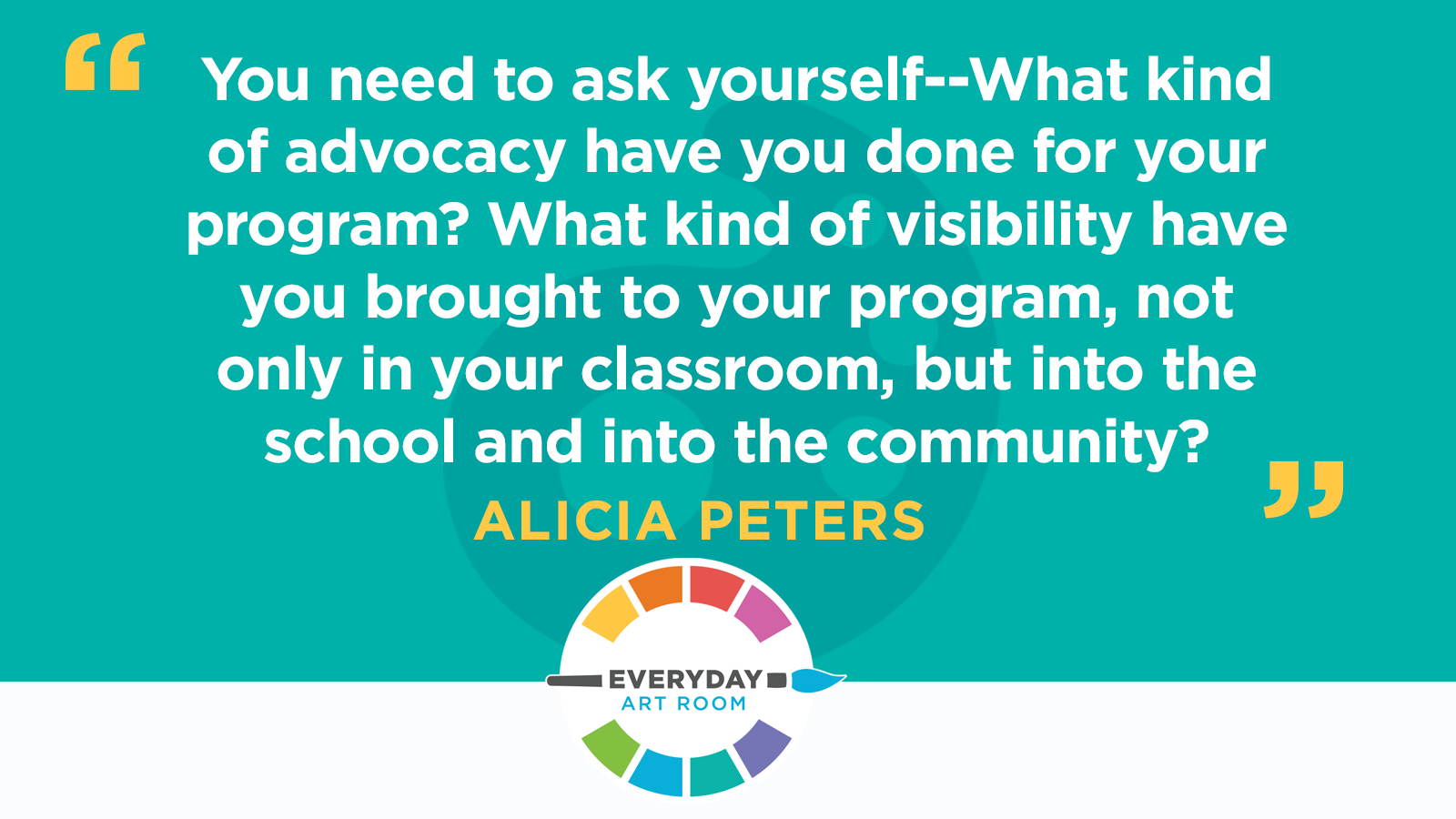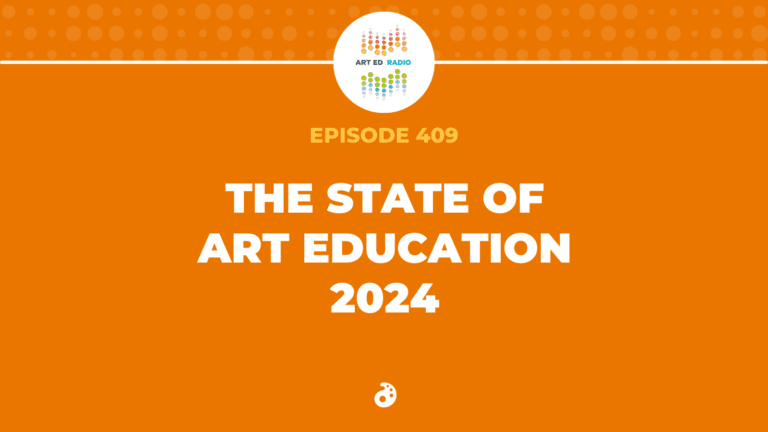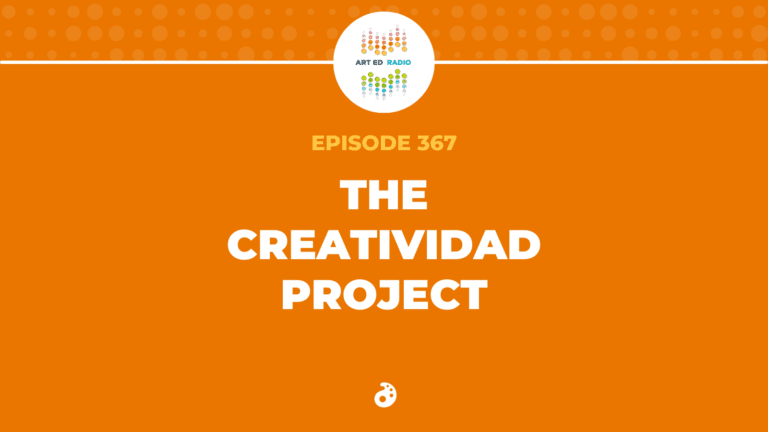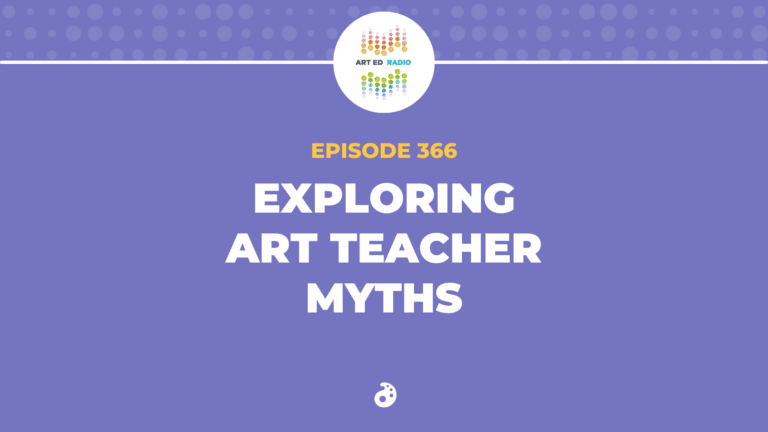Advocacy is always relevant, but it is especially important now with online learning happening everywhere. Now is a good time for us to be advocating for our program and reminding people of the importance of what we do. Listen as Nic brings on Alicia Peters to discuss content, curriculum, standards, and the importance of advocating for ourselves. Full Episode Transcript Below.
Resources and Links
- View all of AOEU’s resources to help with distance learning
- Why You Should Use Social Media as an Advocacy Tool
- 10 Arts Advocacy Resources Every Teacher Needs to Know
- Check out the YES Network Website and Facebook Page
- See Tiffany Erie’s Franklin Art Studio page

Transcript
Nic: Last week on Everyday Art Room we talked a little bit about advocacy even during distance teaching. How do you explain to people what you’re doing in your classroom, your digital classroom, and then also how do you celebrate the students’ work that is being created at their homes?
Today we’re going to have a little bit of a continuation with that conversation about advocacy. I am bringing a friend of mine, Alicia Peters, to have a conversation about how to make sure that we, as art educators, are making sure that we are advocating for our program, but more so creating a confidence in what we’re doing as teachers.
This is Nic Hahn and this is Everyday Art Room.
Hey, thank you so much for being here today, Alicia. I’m so happy to share your voice with our listeners because I know you and I am just … I know who you are and what you’re all about and I can’t wait for you to share that with our listeners, so let’s get started with that, actually. Can you introduce yourself and kind of give your teaching background and what you’re currently working on?
Alicia: Well, thank you so much for inviting me here. It’s such an honor to be asked to share with all the art educators all over the world really, and it’s just quite a pleasure to be here. My name is Alicia Peters and I have taught, I think, 22 years total in art education. 17 I spent at the ROCORI School District, just a local district here in central Minnesota. Then, for the last six years, I have been teaching at the College of Saint Benedict, Saint John’s University as their art pedagogy instructor. The majority of what I teach are elementary educators. There’s a population of art educators, but not as big as the elementary educators.
I also teach a foundation course in education, in teaching in diverse worlds, and I love it. It’s really been something that I enjoy. It’s also, I work in my community and my community is a big part of who I am and what I do. I also presently have been some endeavor that I’m working on right now that’s been the heart of my being for the last four years, has been with something called the Yes Network. It is in the St. Cloud community. It all started actually from a principal that I used to work with at ROCORI a very long time ago.
It does, this all seems like yesterday we had an awful tragedy at ROCORI where one of our students took a gun to school and took the lives of other students and the Yes Network grew out of this. It’s all about connecting with people and creating connections with people because the young man was very lonely and very alone and we’d never want a kid to feel like that. So the Yes Network, what we do, we go into 18 neighborhoods right now in St. Cloud and we provide access to community and to connections with their kids in their neighborhoods, so everybody has somebody.
My role for the last four years has been the art director for that program. So I bring art, music, dance, theater to kids that aren’t able to get to art camps, like I was able to bring my kid to.
Nic: Wow.
Alicia: Yeah, it’s huge.
Nic: Wow, that’s really special and, out of tragedy, that was such a beautiful thing that you’ve been able to be a part of, so that’s amazing. I’ve always admired you. I’ve known you as an art education leader within our state and I’ve seen you present on several different platforms. You’ve kind of talked about some of your background and then some of the community aspects of what you do, but is there other things that you want to just talk about as far as what your involvement is with art education?
Alicia: Yes. I was asked, actually last year, it was a fun conversation with someone in my department and she said, “What do you say when someone asks you what do you do?” And I said, “Well, I teach. I teach.” And she said, “You know, I think we need a different verb for that because I think when we say we teach, there’s one picture we get in our mind of what that looks like. But we do so many different things.” So I came up with my why was connecting. I connect. And so many things I do is about connecting, like with the Yes Network. It’s about connecting kids to experiences with art. It’s with the students I work with. It’s about connecting them to art so they can bring it to their kids.
I also do Teaching Artists Roster Program in our community, which is connecting artists with art opportunities. I run, I’m President of the Millstream Arts Festival, which is a local festival in our town. So connecting my community to the arts and adapting environments for kids, connecting kids with needs with the art experiences, and then I work closely with the Paramount.
So it’s all about connecting with me and the more I do in the art world to connect people with art, it’s become my art is what I call it. I haven’t painted or drawn for a long time, but I know it’s always there for me. But this has become my art, is the connecting people to the arts.
Nic: That’s beautiful. That’s a very good way to describe yourself because that is how others view you as well. You’re such a leader. I really appreciate that in you, of course. Okay. In your current position you’re working at the college level right now, what is the number one message you’re giving to your students in the courses that you’re teaching and why do you think that that message is important? Why do you think you are teaching what you’re teaching and how you’re teaching?
Alicia: The one piece I’m going to focus on is my future art educators. The elementary educators are a different breed and ones that I focus a lot with in a different way on. But for this I’m going to really focus on my art educators with that. And I joke, they almost get this, I give them like a button or almost knighted into a community and something I tell them, “Yes, you’ve learned pedagogy. Yes, you’ve learned content and all these things are important and those are things that are on their transcript,” right? That they’ve done these things.
Nic: Mm-hmm (affirmative).
Alicia: But something that’s hidden that doesn’t show up on a transcript, doesn’t show up on their teaching license, is that they become an advocate for their discipline. It is something from day one that they need to be aware of and constantly fight for almost. It feels like you’re constantly proving your discipline and proving who you are and what you’re doing in the schools you’re in. I talked to them about that it leads to the strength of their program. And many times they go in and they complain about something they’re not getting, and I said, “What kind of advocacy have you done for your program? What kind of visibility have you brought to your program, not only in your classroom, but into the school and into the community?”
When then supports the sustainability of their program. When things get put on the chopping block or things start to get questioned, it’s no, the importance of your program comes out when you are an advocate for it. I’m not talking about in negative ways, in real positive ways we are advocates for it. I’ve watched them go into programs and just complain and focus on the negative when it really needs to be the positive. How can we bring light to the amazing things our students are doing?
Nic: Yeah. Yeah. Because as art educators, we really do have a front row seat to amazing brains doing amazing things. Right?
Alicia: Absolutely.
Nic: And so it is important to share that information with others because they need to see why this is so important, so that’s a powerful message that you’re sending to our young teachers as they’re coming out into the workforce.
Alicia: It’s hard being a first year teacher and not knowing that going into your first year of teaching, I think can make it even more difficult.
Nic: Yeah. Yeah. Yep. It’s like you’re preparing them. That’s right. That’s what you need to do.
Alicia: That’s all.
Nic: Absolutely. But there are some inequity balances between the classroom teachers and art teachers. Why do you think this is and what do you think that art teachers can do to release that feeling and also strengthen what they’re doing? How do they advocate? What do you suggest?
Alicia: One piece that I get kind of charged up about it, and not everybody I know agrees with some of this, but I’m going for it. I correct my elementary educators about it also. One thing, I’m talking more than anything about elementary art teachers in this conversation and the inequity that happens that ends up working. There’s things that we do as elementary art teachers that get in the way of our program and our profession. One of the things that I will just speak up against, I almost think I need to write a book that says, “I’m not a specialist. I am a teacher.”
The reason I feel so strongly about that is we receive the same degree, the same teaching license as the elementary educators, but they’re called teachers and high school art teachers are not called art specialists. Middle school teachers are not called art specialists. But in the elementary school we do that. We say, “We’re going to the specials, we’re going to the specials.”
It is special. I think everything a kid should do in elementary school should be special. Everything should be special and I think us not wearing the badge as a teacher, we end up getting discounted in ways. If I’m not being called a teacher or represented as a teacher in my school, when discussions happen around pedagogy, around learning, around practice, my voice isn’t valued because I’m put in the special, “You’re the specialist. You’re the specials group.”
Actually, a funny story. When I first started in my job we were called support staff. Support staff. And to move from support staff to specialists was, yeah, that was a big jump, but it’s still not what we deserve. We’re a teacher. Because of this battle and because of going into discussions about classroom, about pedagogy, about good practice, about our students and about our students’ needs, when my voice hasn’t been valued and I’ve heard the conversation, which elementary art teachers will know what I’m saying when I say they call them, “My kids. My kids,” and not, “Our kids.”
I’ve actually printed my teaching license on the front of one of my shirts and I will wear it into a meeting and say, “I’m a teacher just like you. Just like you. I am in the same training, the same background. The only thing that’s different is I have a content area that I’m a professional in. You have a content area, you have many of them, but I have one and I’ve chosen one I love.” And thank God because I love teaching through it.
But just that word specialist, I want that to change. I do tell my elementary educators that I teach, “Do not call them specialists. They are teachers, they are art teachers. They are music teachers. They are all teachers,” so that they’re valued as a real strong voice in that. Some of the other ways … If you want me to keep going, Nic, is that okay?
Nic: Yeah, absolutely. Yeah, no. I love it. And I don’t think you are in any means unique to that. I think that is a conversation I have seen in the art education world and so it’s a really good conversation to have and good philosophy behind it, so thanks for bringing that up.
Alicia: Absolutely. I think it contributes to our advocacy too by being a teacher. I then have a classroom, I then have curriculum, but as specialists sometimes we can be discounted for our space, what our content is. I remember having the school board coming in when they were doing cuts, into my classroom, and looking around and one of them said, “Well this would be a great space for a classroom.” And I looked at him, I said, “It is a classroom. It is a classroom.”
Nic: It certainly is. Oh, my.
Alicia: “I am a teacher. I am a teacher,” and it just comes down to that language, “I am a teacher,” and holding that up instead of specialist. There’s things that we do, and you got to cut me off Nic, if I go too far with this.
Nic: No, we’re having a conversation. This is all about thinking about our position in a powerful way and you’re bringing up some great points. Are there other places that you think teachers can make changes or, I mean we talked about identifying ourselves, but are there other areas?
Alicia: Management, I would say, and how we treat our management in our classroom and really believing in the management in our classroom, and having confidence in the management in our classroom. I used to get the conversation when classroom teachers would drop them off and say, “Everybody has gone to the bathroom, no one should need to go,” and they would say it like I don’t have a process in my classroom for going to the bathroom. Or leaving my classroom, where all these processes I have put in place and have routines in my classroom and believing them.
Kids are creatures of habit and we don’t give them enough credit really of learning what the space is like. I would get discounted by classroom teachers by saying, “You only see him once a week. It’s got to be so hard to establish those types of routines,” and I’d say, “Absolutely not. Kids know. Kids are smart. They know how to act and you put them in many different situations in school and they know what to do.” And I would jokingly ask the classroom teachers, I’d say, “Do you get pulled over by the cops every day?” They’d say, “Well, no.” And I said, “Well, how do you know how to act? How do you know how to act?”
It’s because we’ve created a culture around it and I’ve created a culture in my classroom, so no, I don’t need you to tell me that my kids, our kids, right, cannot leave the classroom to use the bathroom, and I don’t like having that control anyway.
You know the behavior sheets that we fill out and then they end up being, “Wait till dad comes home,” kinds of situations? I was just asking my daughter this morning if she remembered when her teacher would pick them up from the art teacher and the teacher would ask, “Well how were they?” And it was, “Oh, they were rough and they weren’t listening,” and all these things. Then I said, “What happened when you went back to the classroom?” She goes, “Oh, we got in so much trouble by our teacher.” And then you get the notes, right, by the classroom teacher. Then you get the notes, “I’m so sorry Ms. Peters for doing this in your classroom.”
It felt like, “Wait till your dad comes home,” kind of situation. It wasn’t like … And then you lose all credibility and they feel like they constantly need to swoop in and save you when they’re not. They’re really minimizing you, that you’re not able to care for and manage your own classroom. We so many times see it as, “Oh, they’re helping me,” and it really isn’t. There’s a control factor there. They’re trying to control your space and what you do with your students. We really need to be mindful of that and be confident in what I do here I believe in.
My students are safe and happy and I’ve created culture where they’re cared about. You need to trust me. I do not need your help. There are situations absolutely, and you know the teacher you can go to and have that conversation about a kiddo that’s struggling and it needs to be collaborative. It isn’t, “What did they do? I’m going to take care of it.” It’s, “What happened and how can we together, as teachers, support this kiddo and support their needs so we can create a space where they feel cared about?”
Nic: Yeah, yeah.
Alicia: Absolutely.
Nic: I think all that you’re saying is, “Yes. I agree with you in many, many ways, but I also believe that there is some subconscious to it as well on both parties. So it’s just great food for thoughts of what are the things and how can we change them?” So let’s get into that a little bit. What are these that art teachers can create a culture of respect in their community and within their school?
Alicia: I don’t want this to be down on classroom teachers because I don’t believe their fault. I think it’s something we do to ourselves and we allow this to happen. We allow them to take over our classroom. I think the one thing is to really change the confidence that you have in yourself and your classroom management. If you want support for classroom management, there’s lots of ways to get it. It isn’t having someone swoop in and do it for you, so you got to be careful for that.
Putting plans and processes in place that are consistent with your students. I think that’s something I repeat to my future educators, “Just be consistent, be consistent, have a process for it. Teach the process,” and they all come back after their first year and they’re like, “Oh my gosh, you’re so right. Being consistent is so important.”
And then if you’re faced with a situation where a classroom teacher says something to you about management, like one that they would say is, “If so-and-so’s not behaving well, you can send them back to the room,” and I would always think about that in reverse. Does that work in reverse? And I would kind of throw it out and say, “Oh, it goes the same for you. Throughout the day if this kiddo’s struggling, you can send them to my room,” and it doesn’t make sense.
That’s not how that should work. So I would always try to reverse it in my head, if what they’re asking is something that they would ask of me as a teacher, as a teacher, and be a real collaborative and something that is reciprocal. If it isn’t reciprocal and doesn’t make sense, then it is something that is about power and not about really a collaborative, caring environment.
Nic: Yeah, that does make sense. Yeah, I can see that. What else? We have another few minutes here. Is there anything else that I’m missing as far as our conversation that we’re speaking about today?
Alicia: I think it’s very relevant right now too, even with the distant learning and the remote learning that’s happening in all of our schools right now. It’s become more relevant for us to really be advocating for our program and still allowing us to be that teacher and the importance of our content as a teacher, as we have curriculum, and content, and standards that we’re teaching.
Continue to build your program and fighting for that time with your students because a lot of times it does get dismissed. I know, I’ve heard stories about the art project being on the bottom of the pile, then it disappears so they make room, so the students never see it. It’s just continuing to fight for time with your students and continuing to build your program. I have a friend in Rochester right now, Tiffany Erie, and she just created this amazing virtual art show.
Oh my gosh. I’ve watched it just take off on her school site. I mean they really … What a beautiful way to really continue to be relevant in the program. I mean it took her a long time. I asked her, “How long?” She said maybe not four hours, but it was a long time. But it really is something relevant we can do.
This is a side story of something I do also, I have another friend here that teaches at Westwood Elementary in St. Cloud, Kristen Dollman Stoll, and I always make sure I send my new art educators to her early in the morning. I said, “I need you to walk down the hallway with her. I need you to hear all the kids tell her things constantly down the hallway.” They constantly stop her. She cannot walk from point A to point B without every single kiddo sharing something with her.
We do teach 600 students in the elementary school. We absolutely do. I tell them, “It’s like building a castle.” She’s been able to create those relationships from kindergarten through fifth grade. And I know it’s hard to connect with every student, especially with this remote learning, but we get them every single year and we get to make those connections. That’s just one thing we do in our school and in our community, it’s creating those relationships, taking time to notice every kiddo and see them as they walk down the hallway.
I want my students to feel that, and what she feels when she walks down the hallway. Stay with the kids and the parents and stay on their radar, especially the admins too. Stay on their radar through this time in little ways we can, having a presence on social media. A couple of years ago I was the art teacher in sixth grade over here in our community school to get back in the classroom again. I missed it and I think I sent the social …
I found out her name. I said, first of all, “Who’s the social media person for the district?” And I just sent constantly something to her, every other day I made sure. I think we need to continue doing that, even with our remote learning. I’ve watched the beautiful things that you’ve shared Nic, on Instagram for your kids. Just having the district know about those things are just so important.
Nic: We’ve been talking a little bit about that last week, actually. But I think point that you made of having a social media presence in this time right now is very powerful, but it doesn’t have to be yours. Reaching out to your district and utilizing what they already have, making sure that your administration knows how hard you’re still working, and how your students are working in your class are all great ideas to advocate outside of the classroom like this.
Alicia: Absolutely. I really liked being the person they were kind of sick of. I really did.
Nic: Yeah, that’s an okay thing, right?
Alicia: Yeah, it is an okay thing. I messaged the social media person, which I figured out who they were, and I said, “You are going to be so tired of me. You’re going to be so tired of me,” and what they came back with was, “We love content. We love content,” so the more we can get the content out there, and the more we can share about our program, and the more we can be advocates for it, and the more we represent ourselves as teachers.
Please, for people who listen to this. If you leave with one thing it would be that you are an art teacher and to really wear that proudly so that when you are sitting at a table, when you are talking about kids and good pedagogy, and good practice, and classroom management, and that you’re represented as a teacher and your voice is valued.
Nic: Thank you so much for taking the time to chat with us today about these really thought-provoking ideas.
Alicia: Oh, thank you for having me. It was really awesome. It was great.
Nic: I’m so glad that my friend Alicia Peters was willing to join us today because I have never had a conversation with her where I haven’t left pondering what we had just talked about. I knew that she was going to bring the food for thought that our brains need right now, things to think about as we are distance teaching and as we are thinking about education in general, and she did a great job.
If you are looking for ways to advocate for your program, advocate for you as a teacher, the Art of Education University is there for you. We have tons, oh so many articles, on how to advocate for your program. Go ahead, check out the magazine, check out the podcasts and, of course, the new webinars that we have. Actually, they’re not so new. We have quite a few Thursday episodes of webinars all ready for you to catch up on if you have missed them.
If you’re not, if you’re attending every single one of them, I know that you’re gaining lots of information of how to best teach online, so the Art of Education University has what you need. Be sure to check it out and utilize everything we are giving to you to make you the best art educator that you can possibly be.
Magazine articles and podcasts are opinions of professional education contributors and do not necessarily represent the position of the Art of Education University (AOEU) or its academic offerings. Contributors use terms in the way they are most often talked about in the scope of their educational experiences.



